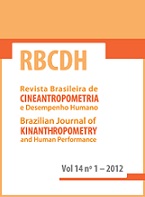Valididy of the anthropometric equations for the estimated muscle mass in the elderly
DOI:
https://doi.org/10.1590/1980-0037.2012v14n1p23Abstract
The objective of this study was to compare skeletal muscle mass (SMM) in older adults estimated by dual-energy X-ray absorptiometry (DXA) and three predictive equations. A total of 180 older adults (120 women and 60 men) aged 60 to 81 years were studied. Appendicular SMM was measured by DXA and estimated using predictive equations based on anthropometric measures, age, race, and gender. Agreement between methods was evaluated by the paired t-test, Pearson’s correlation coefficient, and dispersion error. The prevalence of sarcopenia estimated with the different methods was compared using the kappa coefficient, sensitivity, and specificity. No difference was observed in mean SMM estimated by the predictive equation of Lee et al. and DXA (p>0.05), with a high correlation between methods in both men (r=0.90; p<0.001) and women (r=0.86; p<0.001). The prevalence of sarcopenia did not differ between methods (DXA = 33.3% vs equation = 36.1%), with high agreement between methods (kappa = 0.74; p<0.001) and high specificity (89%) and sensitivity (86%). The results indicate agreement between DXA and the predictive equation of Lee et al. for the estimation of SMM and the prevalence of sarcopenia in older adults.



